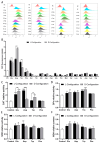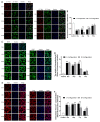Chiral Amino Acids Mediate Mitochondria-Dependent Apoptosis of Human Proximal Tubular Epithelial Cells Under Oxidative Stress
- PMID: 39769204
- PMCID: PMC11677210
- DOI: 10.3390/ijms252413439
Chiral Amino Acids Mediate Mitochondria-Dependent Apoptosis of Human Proximal Tubular Epithelial Cells Under Oxidative Stress
Abstract
Amino acids are the basic structural units of life, and their intake levels affect disease and health. In the case of renal disease, alterations in amino acid metabolism can be used not only as a clinical indicator of renal disease but also as a therapeutic strategy. However, the biological roles and molecular mechanisms of natural chiral amino acids in human proximal tubular epithelial cells (HK-2) remain unclear. In this study, cell viability assays revealed that chiral acidic amino acids (Glu and Asp) and aromatic amino acids (Trp and Phe) inhibited cell growth. The molecular mechanisms indicated that cell growth was closely related to ROS levels. Specifically, chiral Glu, Asp, Trp, and Phe induced oxidative stress and mitochondria-dependent apoptosis in HK-2 cells. This was manifested by elevated levels of intracellular ROS, 8-OHdG, and MDA, increased activities of antioxidant enzymes CAT, SOD, and GPx, decreased mitochondrial membrane potential, increased cytoplasmic Ca2+ concentration, and cell acidification. The expression levels of apoptosis-related molecules Caspase-9, Caspase-3, Cyt-C, and Bax were increased, and the expression level of anti-apoptotic molecule Bcl-2 was decreased. Moreover, L-Glu, D-Asp, L-Trp, and D-Phe exhibited a more pronounced inhibition of cell growth and elicited more substantial alterations in gene expression compared to the other configurations.
Keywords: HK-2 cells; ROS; apoptosis; chiral amino acids; mitochondria-dependent; oxidative stress.
Conflict of interest statement
The authors declare no conflicts of interest.
Figures






Similar articles
-
Prohibitin protects proximal tubule epithelial cells against oxidative injury through mitochondrial pathways.Free Radic Res. 2015;49(11):1393-403. doi: 10.3109/10715762.2015.1075654. Epub 2015 Sep 2. Free Radic Res. 2015. PMID: 26198983
-
Protective effect of carnosine on hydrogen peroxide-induced oxidative stress in human kidney tubular epithelial cells.Biochem Biophys Res Commun. 2021 Jan 1;534:576-582. doi: 10.1016/j.bbrc.2020.11.037. Epub 2020 Dec 1. Biochem Biophys Res Commun. 2021. PMID: 33276949
-
Mitochondrial dysfunction is involved in aristolochic acid I-induced apoptosis in renal proximal tubular epithelial cells.Hum Exp Toxicol. 2020 May;39(5):673-682. doi: 10.1177/0960327119897099. Epub 2019 Dec 30. Hum Exp Toxicol. 2020. PMID: 31884831
-
COMMD5 counteracts cisplatin-induced nephrotoxicity by maintaining tubular epithelial integrity and autophagy flux.Am J Physiol Renal Physiol. 2024 Nov 1;327(5):F739-F757. doi: 10.1152/ajprenal.00026.2024. Epub 2024 Sep 19. Am J Physiol Renal Physiol. 2024. PMID: 39298552
-
Bcl-X(L) translocation in renal tubular epithelial cells in vitro protects distal cells from oxidative stress.Kidney Int. 2001 May;59(5):1779-88. doi: 10.1046/j.1523-1755.2001.0590051779.x. Kidney Int. 2001. PMID: 11318948
References
MeSH terms
Substances
Grants and funding
LinkOut - more resources
Full Text Sources
Research Materials
Miscellaneous

